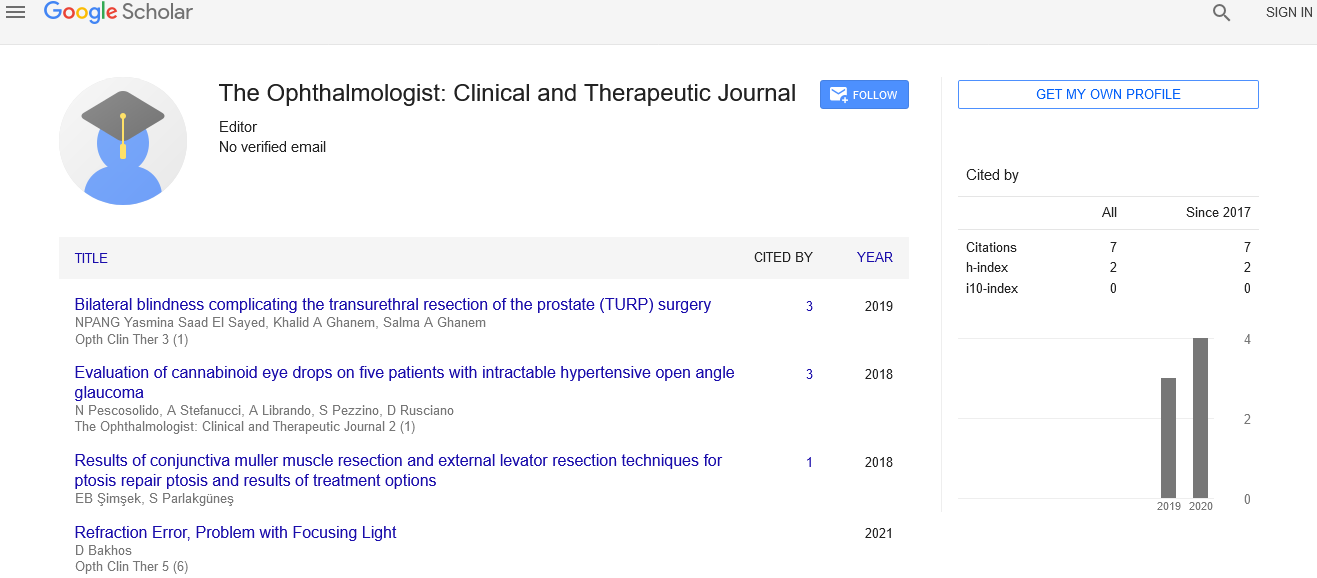Screening of diabetic eye disease
Received: 10-Jan-2022, Manuscript No. PULOCTJ-22-4256; Editor assigned: 12-Jan-2022, Pre QC No. PULOCTJ-22-4256(PQ); Accepted Date: Jan 12, 2022; Reviewed: 18-Jan-2022 QC No. PULOCTJ-22-4256; Revised: 21-Jan-2022, Manuscript No. PULOCTJ-22-4256(R); Published: 11-Feb-2022, DOI: DOI:10.37532/puloctj.22.6.1.1
Citation: Mertens O. Screening of diabetic eye disease. Opth Clin Ther. 2022;6(1):1.
This open-access article is distributed under the terms of the Creative Commons Attribution Non-Commercial License (CC BY-NC) (http://creativecommons.org/licenses/by-nc/4.0/), which permits reuse, distribution and reproduction of the article, provided that the original work is properly cited and the reuse is restricted to noncommercial purposes. For commercial reuse, contact reprints@pulsus.com
Abstract
To concentrate on the chance of building a far off translation framework for retinal pictures. An Ultra-Wide Field (UWF) retinal imaging gadget was introduced in the inside medication division spend significant time in diabetes to acquire fundus pictures of patients with diabetes. Far off understanding was directed at Nagoya City University utilizing a cloud server. The clinical information, seriousness of retinopathy, and recurrence of ophthalmologic visits were breaking down.
Key Words
COVID-19, ultra wide field retinal imaging framework, optos
Introduction
Diabetes mellitus causes both macrovascular intricacies, like coronary course illness, fringe blood vessel sickness, and stroke, and microvascular complexities, like diabetic nephropathy, neuropathy, and retinopathy. Diabetic Retinopathy (DR), one of the most well-known microvascular complexities and quite possibly the most well-known reasons for visual deficiency in working-age populace, is presently the subsequent driving reason for visual hindrance in Japan after glaucoma. While inside medication experts treat diabetic nephropathy and neuropathy, ophthalmologists ought to analyze and treat retinopathy. In Japan the joint effort between the Internal Medicine and Ophthalmology divisions in an overall emergency clinic isn’t sufficient 100% of the time. The Optos Daytona (Optos PLC, Dunfermline, United Kingdom), an Ultra-Widefield (UWF) Retinal Imaging Framework, utilizes a checking laser ophthalmoscope that can acquire retinal pictures without mydriasis. This imaging framework was intended to conceal to 200° of the retina with a definite perspective on the macula in one picture. Thusly, many reports have portrayed that the nonmydriatic UWF imaging got utilizing this instrument is helpful for assessing DR. This imaging framework is additionally conservative and light and can be introduced in restricted spaces. The activity is straightforward, and with negligible preparation, a specialist, orthoptist, or medical caretaker can get a picture. In any case, the pictures gave because of the imaging conditions and relics are conflicting, and it could be hard for ophthalmologists who look at the fundus in day by day clinical assessment to arrive at an exact determination. The fundamental motivation behind this study was to concentrate on the chance of building a framework for far off translation of retinal pictures. We additionally assessed the relationship among boundaries like diabetes history, seriousness, BP, and DR seriousness. We then, at that point, surveyed the beginning of DR and assessed whether or not there is plausible of viable administration and treatment through proper coordinated effort between the Internal Medicine and Ophthalmology offices.
Result
501 patients gave assent and partook in the review between September 2018 and June 2019. Of the patients who gave assent, two patients were excluded in light of helpless picture quality. Furthermore, albeit the pictures were given to ophthalmologists to understanding, the pictures of one eye every one of two patients were thought of as muddled, and one eye of every one of the two cases was assessed. Whenever the seriousness of the DR contrasted between the left and right eyes of a patient, the seriousness of the more extreme eye was utilized. Assessment of the seriousness of DR in patients who had never had an ophthalmologic assessment showed that 86 patients (82.7%) had no DR, 11 (10.6%) patients gentle NPDR, six (5.8%) patients moderate NPDR, and one patient (1.0%) extreme NPD. The seriousness of DR in patients who had never had an ophthalmologic assessment was altogether lower than in patients who had an ophthalmologic assessment inside a year (P < 0.01 Wilcoxon marked position test). Hence, far off assessment is helpful for patients with diabetes who live in rustic regions a long way from an ophthalmology facility or for working patients in their 40 s and 50 s who are too occupied to even think about seeing an ophthalmologist. In rundown, 28% of patients with diabetes who visited the Internal Medicine Department were determined to have DR, and 8% had serious NPDR or PDR. About half (48%) of patients had a background marked by an ophthalmologic assessment inside 1 year, however one of every five (21%) had no such history. Retinopathy would in general turn out to be more serious in more established individuals with longer lengths of diabetes and higher HbA1c values. Far off understanding of DR was conceivable by introducing a UWF fundus imaging gadget in the Internal Medicine Department consistently visited by patients with diabetes. Patients with extreme DR for the most part were analyzed regularly, however numerous patients in whom retinopathy created had no set of experiences of an ophthalmologic assessment. Distant understanding of DR utilizing UWF fundus imaging might be valuable for evaluating for diabetic retinopathy particularly during the COVID-19 pandemic.





